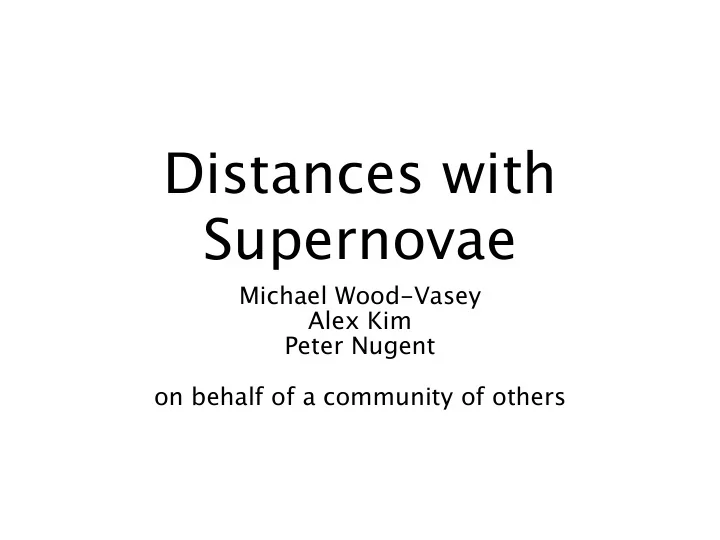

Distances with Supernovae Michael Wood-Vasey Alex Kim Peter Nugent on behalf of a community of others
SN Ia Data at the Beginning of the LSST Era High-redshift: 5,000 Low-redshift: 2,000 • • DES SNfactory • PS-1/PS-2 • Palomar Transient Factory • SNLS • La Silla Supernova Search • SDSS-II • Carnegie Supernova Program • ESSENCE • Center for Astrophysics Optical+NIR Spectra • KAIT/LOSS survey High-z: • NOAO/WIYN NIR SNeIa Confirmation • SkyMapper Evolution studies • Zwicky Transient Factory Low-z: Indepth UV-NIR • YUFSS (Your Unjustly Forgotten Supernova Survey) Spectrophotometry
Current and Future SN Surveys Dark Energy Survey photo: Rich Talcott +SkyMapper, DES, KAIT, PTF , ... Pan-STARRS 1 photo: John Tonry SuperNova LSST Legacy Survey photo: LSST Corporation photo: Tom Kerr
Taking pictures is sufficient for measuring w in an ideal world. 10,000 SNe Ia 1.2 −0.6 1 Photo-z −0.7 Spec -z 0.8 −0.8 0.6 P(w) −0.9 0.4 w −1 0.2 Ti Grid −1.1 0 Flexure -0.2 −1.2 -1.6 -1.4 -1.2 -1 -0.8 -0.6 -0.4 w −1.3 LSST SNeIa alone constrain constant w in a flat Universe −1.4 0.1 0.2 0.3 0.4 Ω Μ (LSST Science Book arXiv:0912.0201)
50,000 SNeIa Constrain Evolving w in a Flat, Kind Universe 2 1 0 a −1 w −2 −3 −4 −1.1 −1 −0.9 −0.8 −0.7 w 0 (LSST Science Book arXiv:0912.0201)
What Do We Need to Achieve LSST Projection The three challenges are all focused on reducing systematics: • Photometric Calibration – largest limiting factor in the use of SNe Ia today as cosmological probes. 80% of w-OM systematics area • Supernova Ia Calibration – determine the best way (smallest statistical and systematic errors) to use SNe Ia to measure distances. • Spectroscopy – eliminate and constrain non-SN Ia contamination. Learn physics.
Current State of SN Ia Cosmology SNLS: Conley et al. (2011); Sullivan et al. (2011)
Current State of SN Ia Cosmology SNLS: Conley et al. (2011); Sullivan et al. (2011)
Current State of SN Ia Cosmology SNLS: Conley et al. (2011); Sullivan et al. (2011)
Astronomical Calibration Extinction above the atmosphere Source Atmosphere Instrumental transmission “Metrology and Meteorology” Historical Integral-constraint-approach insufficient Must now separately determine each component (Chris Stubbs)
Spectrophotometry is Ideal: S( λ ) K-corrections S-corrections Wavelength Date Date Wavelength (SNfactory)
Spectra Test z Evolution of S( λ ) Normalized Flux Wavelength [Angstroms] (Ellis et al 2008; Maguire et al 2012; also Foley et al. 2008
NIR Helps Measure Dust: G( λ ) R V = 3.1 R V ~ 1-2 Extinction [mag] Goobar p=-2.4+/-0.1 Goobar p=-2.5+/-0.1 Goobar p=-0.7+/-0.2 Goobar p=-3.5+/-1.1 CCM+O Rv=1.7+/-0.1 CCM+O Rv=1.6+/-0.1 CCM+O Rv=4.4+/-0.6 CCM+O Rv=1.1+/-0.8 CCM+O Rv=3.1 CCM+O Rv=3.1 CCM+O Rv=3.1 CCM+O Rv=3.1 Wavelength (Folatelli et al. (2010); also Goobar 2008; Amanullah & Goobar 2011)
NIR SNeIa measure Distance to 5% 20 PAIRITEL SNeIa 18 literature SNeIa 16 m H 14 M H = -17.98 12 ( � M , � L , h 0 ) = (0.23, 0.77, 0.72) 1.0 RMS = 0.15 mag 0.5 m H - (M H + µ � CDM ) 0.0 -0.5 � z = 150 km/s -1.0 1000 10000 Velocity [km/s; CMB+Virgo] Barone-Nugent et al. (2012) Wood-Vasey et al. (2008)
We are Obtaining more SNIa NIR RAISINS HST WIYN PS1 CSP Gemini du Pont PAIRITEL Going to z>0.1 requires space[*]
z~1 NIR SNeIa Requires Space With Current Technology Ground Sky is 100x brighter than Space in NIR: Ground Sky is not transparent in NIR: absorption due to water is very strong and extremely variable (Courtesy Bob Kirshner)
z~1 NIR SNeIa Requires WFIRST Ground Sky is 100x brighter than Space in NIR: Ground Sky is not transparent in NIR: absorption due to water is very strong and extremely variable (Courtesy Bob Kirshner)
Calibrate Atmosphere with GPS 1.0 1.0 0.8 Transmission 0.6 i+z z y 0.8 0.4 0.6 O2 τ H2O 0.2 Rayleigh Aerosol O3 0.4 0.0 0.4 0.5 0.6 0.7 0.8 0.9 1.0 1.1 Wavelength ( µ m) 1.2 σ =1.5% 0.2 1.0 0.8 0.6 Flux 0.4 0.0 0.2 0.0 0.2 0.4 0.6 0.8 0.0 0.1xPWV(mm) + 0.36x(AM-1) -0.2 1.2 σ =2.9% 1.0 Blake and Shaw (2011) 0.8 0.6 Flux 0.4 0.2 0.0 -0.2 0.930 0.932 0.934 0.936 0.938 0.940 Wavelength ( µ m)
Can We Peer Through Atmosphere? OH-Suppression Atmospheric OH emission lines Deserves Sigificant R&D Zodiacal sky background – from space Ellis & Bland-Hawthorn, MNRAS (2008) (Courtesy Saul Perlmutter)
Kunlun Dark Universe Survey Telescope: An Optical / IR Observatory on The Antarctic Plateau The Site: Elevation: 4091 meters • Turbulence Boundary Layer: • 14.5 meters Best Seeing • Free Atmospheric Seeing: 0.3” Low Scintillation Noise: 0.5 • mmag (m -2/3 s -1/2 ) Observable Nights: > 90% • Coldest Point on Earth: • Lowest Thermal IR Background Lowest Precipitable Water • Cook’s Branch, April 12, Content 2012
Can we Look at Less Atmosphere? Multi-Conjugate Adaptive Optics (UofA) Can we do both AO + OH-suppression? (Gemini)
Future of SNIa Cosmology • 2010-2020 • SNIa Astrophysics (optical-NIR) • Astronomical Calibration • Photometric-only analyses • 2020-2030 • LSST • +Euclid, +JWST • <1% metrology and meterology • 2025-Beyond • Ground-based AO+OH suppression • Space-based restframe NIR • Fundamental limits to SNe Ia?
Recommend
More recommend